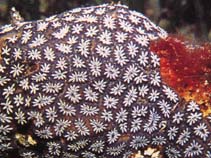Botryllus schlosseri (Pallas, 1766)
Golden star tunicateWarning: DOMDocument::load(): SSL operation failed with code 1. OpenSSL Error messages: error:140770FC:SSL routines:SSL23_GET_SERVER_HELLO:unknown protocol in C:\Apache24\htdocs\includes\SpeciesSummary.lib.php on line 1236
Warning: DOMDocument::load(): Failed to enable crypto in C:\Apache24\htdocs\includes\SpeciesSummary.lib.php on line 1236
Warning: DOMDocument::load(https://sealifebase.nrm.se/webservice/AquaMaps/getAMap.php?genus=Botryllus&species=schlosseri): failed to open stream: operation failed in C:\Apache24\htdocs\includes\SpeciesSummary.lib.php on line 1236
Warning: DOMDocument::load(): I/O warning : failed to load external entity "https://sealifebase.nrm.se/webservice/AquaMaps/getAMap.php?genus=Botryllus&species=schlosseri" in C:\Apache24\htdocs\includes\SpeciesSummary.lib.php on line 1236
Classification / Names Common names | Synonyms | CoL | ITIS | WoRMS
Ascidiacea | Stolidobranchia | Styelidae
Environment: milieu / climate zone / depth range / distribution range Ecology
Sessile; depth range 0 - 100 m (Ref. 1603). Temperate; 71°N - 38°S, 180°W - 180°E
Distribution Countries | FAO areas | Ecosystems | Occurrences | Introductions
Cosmopolitan.
Length at first maturity / Size / Weight / Age
Maturity: Lm ? range ? - ? cm Max length : 5.0 cm TL male/unsexed; (Ref. 1603)
Assumed maximum total length of zooids from Ref. 1603, 2268. Width of encrusting colonies is 10 cm (Ref. 7726). Attached to hard substrata; mainly in shallow water but occasionally to depths of several hundred meters (Ref. 1603). Common encrusting form in shallow subtidal waters on hard surfaces, and covers algae (Ref. 7726). Trophic level: 1.4-1.8; filter-feeder (Ref. 96418).
Life cycle and mating behavior Maturity | Reproduction | Spawning | Eggs | Fecundity | Larvae
Members of the class Ascidiacea are hermaphroditic; both cross- and self-fertilization is typical. Life cycle: Eggs develop into lecithotrophic larva before metamorphosing into benthic adults.
Main reference
References | Coordinator | Collaborators
Jagerskiold, L.A. 1971. (Ref. 1369)
IUCN Red List Status (Ref. 130435)
CITES status (Ref. 108899)
Not Evaluated
CMS (Ref. 116361)
Not Evaluated
Threat to humans
Human uses
| FishSource |
Tools
More information
Internet sources
BHL | BOLD Systems | CISTI | DiscoverLife | FAO(Publication : search) | Fishipedia | GenBank (genome, nucleotide) | GloBI | Gomexsi | Google Books | Google Scholar | Google | PubMed | Tree of Life | Wikipedia (Go, Search) | Zoological Record
Estimates based on models
Preferred temperature
(Ref. 115969): 8.1 - 19.4, mean 11.7 (based on 1362 cells).
Price category
(Ref. 80766):
Unknown.



